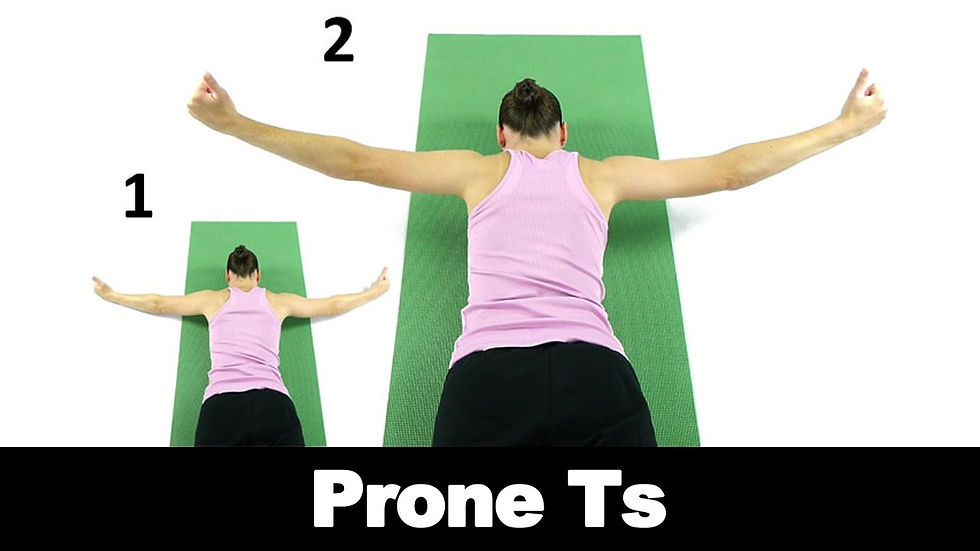Get rid of neck pain at home!
- Steven Schwab
- Feb 17, 2022
- 4 min read

Does your neck constantly feel tight or stiff? Do you occasionally get headaches that radiate into certain parts of your head? Are you tired of constantly buying/trying new pillows with no luck? In this article, I list specific exercises and stretches that will help you!
Majority of peoples neck pain and stiffness stems from what is termed the "upper cross syndrome". This is a fancy term for labeling bad posture resulting from specific tight and weak muscles. The picture below depicts the certain tight and weak musculature. The cure for this is quite simple, yet requires work and patience. Simply put, one must strengthen the weak muscles and loosen/stretch the tight muscles. Although this can be achieved simultaneously, it's usually better to gain 'mobility' before 'stability' AKA loosen up before strengthen.

Now, let's first discuss how to loosen, or free-up, the tight musculature. An efficient way is through visiting your local physical therapist of whom will provide various myofascial techniques such as soft tissue mobilization, dry needling, or trigger point release. If you'd like to try to loosen these up on your own, I will provide stretches for each muscle group.
The first picture is the best way to stretch your upper trapezius and levator scapulae. The first step is find a comfortable chair. Prior to the stretch, sit as upright as possible with good posture! If you are stretching the right side of your neck, then grab underneath the chair with your RIGHT arm, tilt your head to the left and look down at your left knee. Then slowly lean your entire body to the left, you should then start feeling a stretch in the back/right side of your neck. Hold for 45 sec-1 minute. For a stronger stretch, you can use your left arm to tilt your head more to the left.

Now, let's stretch out those pectoral muscles! An efficient way to loosen these would be with a physical therapist through myofascial techniques such as soft tissue mobilization, dry needling, or trigger point release. If you'd like to stretch these on your own, then below goes into detail.
The "doorway stretch" is an easy, great way to stretch your pectoral muscles. First, find a doorway and maintain a good, upright posture. You can stretch both pectoral's at the same time, or isolate each one. You place your forearm on the doorway and slowly lean forward with your bodyweight. You will start to feel a stretch in the front of your chest, hold for 45 sec-1 minute. For a stronger stretch, you can do a lunge while 'leaning' into the stretch.

Now that we have stretched out those tight muscles, let's start strengthening! I'd highly advise visiting your local physical therapist for there are numerous exercises of which can be progressed accordingly. However, I'll provide you with some simple at home exercises you can try.
It is vital to strengthen your deep neck flexors, for these will take stress off the back of your neck. The ideal exercise is called 'chin tucks'. You can do these lying on your back, sitting up, or standing up. However, lying on your back with no pillow (head completely flat) is the ideal way. The specific cue, is tuck your chin and "make a double chin". Technique is crucial for this exercise. You simply want to bring the tip of your chin, towards your neck and HOLD for 3-5 seconds. The picture below depicts this. Perform 3 sets of 15 repetitions twice a day.

To strengthen the serratus anterior, lower/mid trapezius, and rhomboids can be achieved with many different exercises. I'll give an exercise for each muscle group.
'Serratus punches' can easily be done at home. You lie on your back, extend both your arms toward the ceiling. Once you think you extended your arms all the way, perform a small 'punch' with both arms towards the ceiling. This is a very small motion. You are simply 'protracting' your scapula of which activates the serratus anterior. If performing correctly, you'll start to feel it on the outside aspect of your shoulder blade. Perform 3 sets of 15 repetitions. There is a picture below.

The next group of exercises will work your middle & lower trapezius, rhomboids. These are called prone A's, T's, and Y's. These are all performed on your stomach. I'll go over each in detail.
For prone A's, start on your stomach with both arms flush by your side. First, squeeze your shoulder blades together and DOWN. Then lift both arms up while keeping them completely straight. You will not get a lot of motion with the arms. Rinse and repeat. Perform 3 sets of 15 repetitions.

Prone T's is very similar. Lie on your stomach and extend both arms completely where your making a "T". Next squeeze your shoulder blades together and lift both arms up. Perform 3 sets of 15 repetitions.

Hopefully by now you can imagine how to perform prone Y's! While on your stomach, extend both arms above your head. Squeeze your shoulder blades down and back, then lift both arms up. Perform 3 sets of 15 repetitions.

If you are to implement this regime including daily stretches and exercises, you should start seeing results within 2-3 weeks! If these exercises are "too easy" for you, I suggest getting with a local physical therapist for more advanced exercises. Also please remember, if your neck pain eventually disappears, don't stop doing your exercises or it will come back!
Steven Schwab PT, DPT





Comments